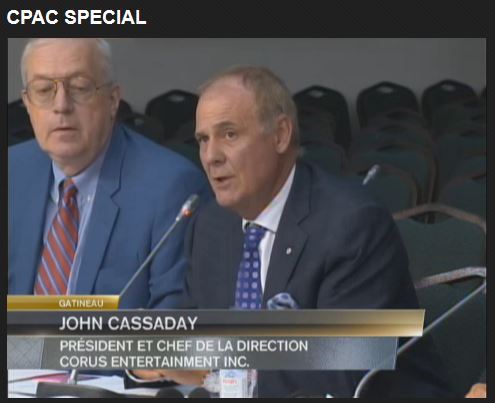
GATINEAU – Late Wednesday evening, after the TV lights had long been turned off and almost everyone else had gone home, Corus Entertainment stated its belief that despite the myriad changes happening in the global media market, the CRTC shouldn’t really do too much to upset the Canadian apple cart.
However, if the Commission does move on a smaller, mandated basic package, which is one of the many proposals under review, Corus asked that new regs be sure to include kids programming in the lineup. Corus is a big kids content producer, of course, but the company didn’t ask that its own channels be the ones included, just that kids be accommodated.
The company also maintained that whatever changes are contemplated and whichever new rules adopted when it comes to consumer choice in television that Canadians be able to choose to keep getting what they already have from their TV providers. “We are concerned that the Commission’s ‘straw man’ proposals represent a significant risk to our system. These are being contemplated at a time when our country continues to struggle and when the adjustments and investments we are making for the digital economy have yet to bear fruit,” said CEO John Cassaday (pictured in a screen cap from CPAC.ca).
The Regulator has to be very careful about changing anything – and about the speed at which they do it – because the rules surrounding TV are already so many, meaning the consequences of changing some aspects of the system can be very problematic for others. “The rules are broad and deep. Canadian content needs to meet certain standards and be certified. Advertising is also subject to standards and review that are unique to Canada. Types and volumes of ads are regulated by various agencies. And even the sound of ads is regulated,” added Gary Maavara, EVP and general counsel.
Corus, to paraphrase, doesn’t see very many problems which the CRTC has to step in and solve, said its executives. “Our view is that the Canadian broadcasting system is working well for all constituents, including consumers. All of the research on the record supports that. We believe that the Canadian broadcasting system already provides Canadians with both tremendous choice as well as diversity in their television services. And we can compete with the new players,” Cassaday added.
With choice as the key word in the hearing – and much of the media coverage surrounding it, Corus filed as part of its written intervention a study by consumer behaviorist, Dr. Dilip Soman, whose research shows that offering consumers too much choice (like hundreds of TV channels to pick from) “can be paralyzing, not empowering,” he said. “Our fear is that if Canadians are pushed away from a system that is working for most Canadians into an à la carte system, many will be paralyzed and default to something that resembles just skinny basic and Netflix.
"Should we be dramatically altering the system when the overwhelming majority of governments are elected with 30% of the vote." – John Cassaday, Corus Entertainment
“We believe that the pick and pay model could well result in the destruction of the existing broadcasting infrastructure and a massive reduction in jobs across Canada. There is nothing on the public record which suggests or supports an economic benefit for consumers or the system with à la carte distribution.”
Commissioner Candice Molnar referenced Cassaday’s use of numbers from a recent CTAM Canada report in his opening speech, which said 57% of Canadians are happy with their TV as it stands now. “Would you say that 57% being satisfied is what we should consider to be a good outcome?”
Cassaday stood his ground. “As a lifetime marketer I would say that having 57% say anything is acceptable to them is great. And the other side of it is how many people are dissatisfied. The answer to that is much, much fewer… So the question is should we be dramatically altering the system when the overwhelming majority of governments are elected with 30% of the vote. We're saying that we have 55% of the vote here,” he explained.
“And on that basis, my answer to your question would be, yeah, I think that's a terrific level of satisfaction.”
There are going to be others with opposing viewpoints, and Cartt.ca will be covering the hearing until its end next Friday, September 19.
The Let’s Talk TV policy hearing continues Friday with Telus, Eastlink and the CBC appearing, among others.
Follow the hearing live on cpac.ca, crtc.gc.ca or on Twitter via @gregobr and @CarttCa


